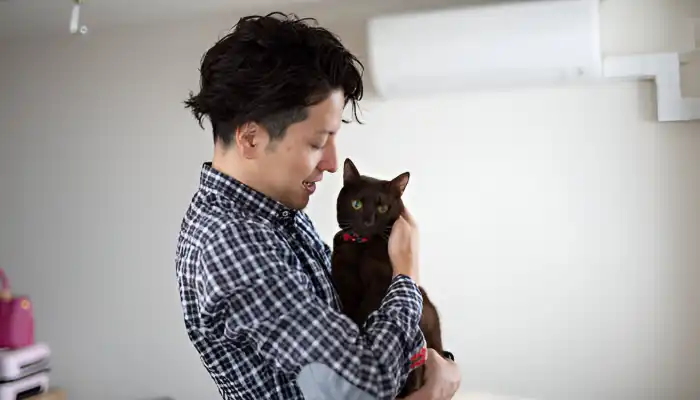How Do I Say “I Love You” in Cat Translator? Cats don’t have a spoken language like humans, so they express love through body language, purring, and other unique behaviors. While they can’t understand verbal affection, cats are skilled at receiving love messages through actions.
In this article, we’ll explore the best ways to translate “I love you” for your cat, including how they show affection and whether cat translator apps can help you understand their love language.

How Do You Say “I Love You” In Cat Language?
How Do I Say “I Love You” in Cat Translator? Unlike humans, cats express their love in unique ways, relying on body language and subtle gestures. If you’ve ever wondered how to tell your feline friend that you love them, understanding their signals is key.
From slow blinking to gentle kneading, cats use various affectionate behaviors to communicate their trust and attachment. Let’s explore some of the best ways to say “I love you” in cat language and strengthen your bond with your furry companion.
1. Slow Blinking
How it works?
- If your cat is looking at you, try blinking slowly and softly at them.
- If they blink back, that’s a show of trust and love—comparable to saying “I love you” in cat tongue.
Why does It work?
- A cat keeps its eyes peeled in the presence of danger.
- A slow blink is executed when they feel safe around you.
2. Purring
How Does It Work?
- If your cat starts to purr while you stroke them, it means you’re appreciated by them.
- When their favorite human is around, some cats may purr even when they don’t get petted.
Why Does It Work?
- Cats usually purr when they’re feeling comfortable, calm, and happy.
- Scientists suggest that purring can help them heal more rapidly and lower their stress.
3. Headbunting & Rubbing:
How Does It Work?
- If your cat loves you, clearly they start to headbutt with you.
- This is how they reassure someone, “You’re mine and you will always be my first.”
Why Does It Work?
- Cats have scent glands on their cheeks and foreheads.
- Their rubbing means claiming you as part of their family.
4. Gentle Kneading
- Your cat might step on you with their paws (like pressing dough).
- This behavior is characteristic of a kitten, and it stays with them into their adult life.
Reason for Effectiveness:
- Comfort is derived from kneading their mother while nursing.
- If they kiss you, it means they feel happy and loved.
The answer lies in understanding your cat’s behavior. Slow blinking, purring, head bunting, and gentle kneading are just a few ways felines express affection.
By recognizing these loving gestures and responding in kind, you can deepen your bond with your pet. Instead of relying on words, embrace the silent yet meaningful language of cats and enjoy a strong, loving connection with your furry friend.
Cat Language Apps: Do They Work?
A lot of people search for “How Do I Say “I Love You” in Cat Translator?” and end up with cat translation apps. Many of these apps suggest that they can “translate” your pet’s meow to human languages and vice versa. Do they though?
| Feature | Cat Translator Apps | Real Cat Communication |
|---|---|---|
| Meow Translation | Yes, but not accurate | Cats meow differently based on tone and situation |
| Body Language | No | Essential for real communication |
| Purring Recognition | Some attempt it | Purring means love, relaxation, or pain sometimes |
| Effectiveness | Fun but not reliable | Observing cats is more accurate |
Do You Recommend Cat Translator Apps?
Cat translator apps are fun to mess around with but not scientifically accurate. Instead of using an app, understand your feline friend’s body language.
Here Are Several Ways To Show Your Cat Love:
Showing your cat love is essential for building a strong bond, but it’s just as important to recognize when your feline is showing affection in return. Here are some simple ways to strengthen that connection and understand how your cat says, “I love you
1. Play Games Together
Why it Matters? :
- Playing and petting your cat during active times reinforces your bond.
- Try using feather wands, laser pointers, and interactive puzzles.
2. Give Treats, but Not Too Many!
Why it Matters? :
- Giving healthy treats to your cat can reinforce positive behavior.
- Choose freeze-dried meat and tiny bits of tuna over sugary treats.
3. Let Them Have Their Boundaries
Why it Matters? :
- Some cats love attention, while others prefer independence.
- Let your cat approach you instead of forcing interaction.
4. Groom and pet them in the right areas.
Favorite Locations To Pet A Cat:
Chin & Cheeks: Most cats love gentle chin scratches and cheek rubs.
Base Of The Tail – A favorite spot for many felines.
Belly – Most cats dislike belly rubs.
5. Ensure They Feel at Ease
Why it Matters? :
- Cats enjoy cozy beds, warm areas, and tall places.
- They need scratching posts and cat trees to feel comfortable.
Signs Your Cat Loves You
If you’re wondering How Do I Say “I Love You” in Cat Translator?, it’s important to recognize when your cat is saying it back!
Ways Your Cat Might Show Affection:
Following You Around – They want to be near you.
Bringing You “” Gifts”—dropping a toy (or prey) at your feet is a sign of love.
Sleeping Near You: Cats sleep close to those they trust completely.
Tail Positioning – A raised, slightly curled tail shows happiness.
Bonus Tip: If your cat flashes their belly, it’s a sign of trust!
By understanding your cat’s needs and recognizing the signs of affection, you can create a loving environment where both you and your feline companion feel secure and cherished.
Conclusion
How Do I Say “I Love You” in Cat Translator? Unlike humans, cats express love through body language and behaviors rather than words. Slow blinking, purring, head bunting, and kneading are ways felines show affection.
While cat translator apps claim to interpret meows, understanding natural cat behaviors is more reliable. Strengthening your bond involves playing together, respecting their space, and recognizing signs of trust like tail positioning and gift-giving. Instead of relying on an app, observe your cat’s unique way of saying “I love you.”
